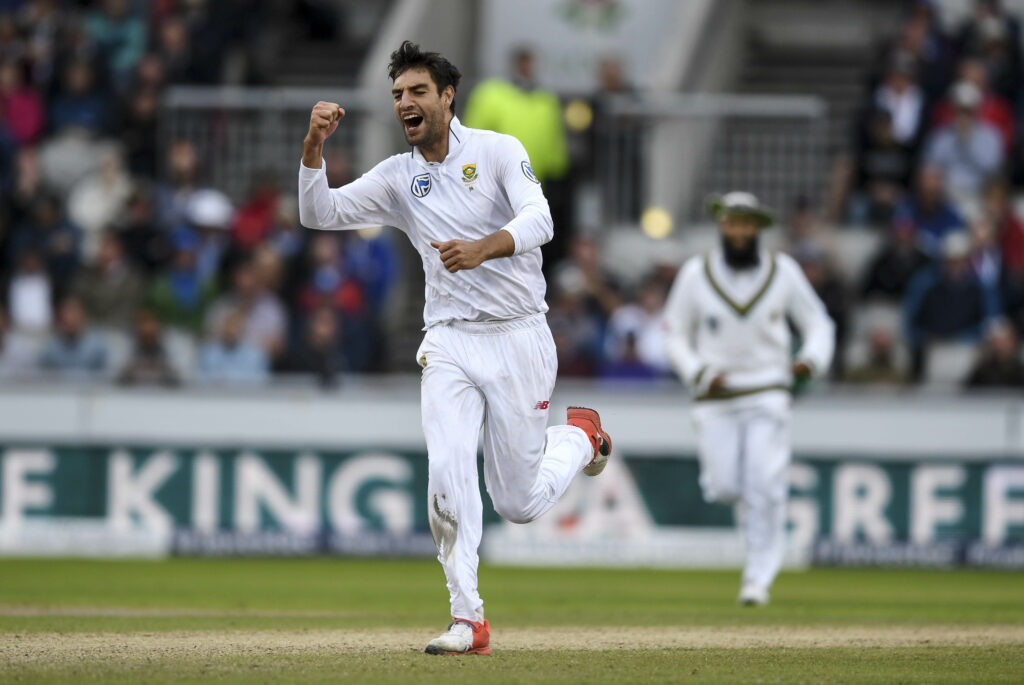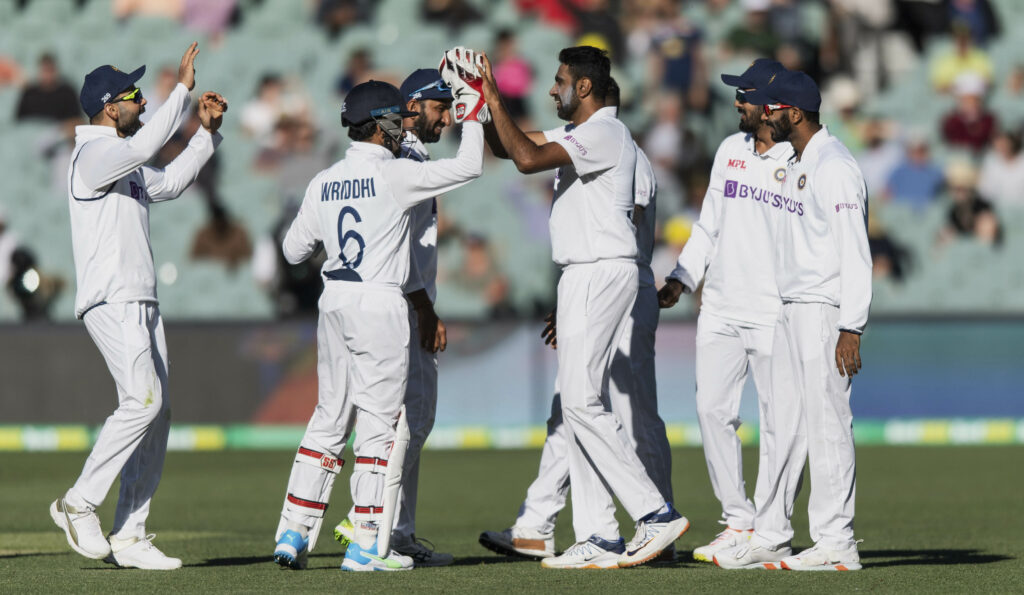A general view of play at sunset during day two of the First Test match between Australia and India at Adelaide Oval on December 18, 2020 in Adelaide, Australia. (Photo by Daniel Kalisz - CA/Cricket Australia via Getty Images)
The New Yorker’s famous baseball writer, Roger Angell, once wrote that summer in the US existed for one reason only, and that was to accommodate baseball. It’s a neat inversion — summer exists for baseball, not the other way round — and I often think of Angell’s conceit when I think of cricket and its place in the African summer, a time in battered Gauteng of hot, still days, and rain-washed evenings.
Summertime is also cricket time, the time of James Joyce’s “pock, pock, pock” of the leather ball on a willow bat. People believe — wrongly, I think — that cricket is just a sport and leave it at that. Cricket is so much more. It’s an enveloping culture, the gentle music to our sun-drenched days. Summer without cricket is like, well, boerewors without the roll, or a major Gauteng thoroughfare without a pothole.
We hear cricket commentary on the radio; we hear shouting from outside on the grass where an “international” is taking place with the neighbour’s children or cousins to the bark of dogs. We might pass a cricket match while heading to the coast in the car. Whose heart hasn’t been twisted with the view from a speeding car window of a pick-up match on a sloping field in some waterless pocket of the land, where the palette is drab and the bat is shared and the very act of playing suggests a quotient of defiance?
The return of cricket this summer is doubly poignant. First, live cricket was often cancelled by the ravages of Covid-19 last season. This was felt most noticeably in the depths of the system, where representative weeks and club and school fixtures were junked.
Despite the encroaching fourth Covid-19 wave, indications are that the system down below has normalised. Boys and girls will get their provincial caps and parents can take to their collapsible chairs fast in the knowledge that the first run out of the morning is but a heady miscalculation away.
Second, need we be reminded, cricket was nearly prised away from those who love it through the latter half of 2019. The troika of former Cricket South Africa (CSA) chief-executive, Thabang Moroe, company secretary, Welsh Gwaza, and Moroe’s replacement, acting chief executive, Kugandrie Govender, almost single-handedly managed to turn cricket upside-down and empty its pockets.
Thankfully the media and civic society howled their disapproval and the minister of sport, arts and culture, Nathi Mthethwa, intervened and put an interim board in place.
Initially through Zak Yacoob and later through Stavros Nicolaou, the interim board stabilised matters at CSA, re-assured the operational staff and calmed what sponsors remained. They saw to it that a new constitution was crafted, with the accent on a majority of independent board directors.
They also saw to it that the first AGM was held in two years and, with a dignity at odds with South African political and corporate life, rode into the proverbial sunset when the job was done. That we have cricket to look forward to over Christmas and New Year is due largely to them.
The core of the summer will be dominated by visitors, India, who play three Tests and three One-Day Internationals through the second half of December and into January, with the first Test starting at Centurion on Boxing Day followed by Tests and the Wanderers and Newlands.
The Indian Test side of today is a very different proposition to the gifted but flaky outfits who came to South Africa say, 20 years ago because those sides could generally be intimidated with fast-bowling. That doesn’t hold anymore. And neither does it hold that Indians are the world’s poorest travellers. To demonstrate why, a story.
This time last year India were bowled out for 36 by Australia in their second innings of the first Test in Adelaide, their top score being Mayank Agarwal’s nine. Although without their talismanic skipper, Virat Kohli, for the traditional Boxing Day Test in Melbourne, India dug deep and posted 326 after Australia’s first innings, 195, with Kohli’s replacement skipper, Ajinkya Rahane, scoring 112.
 Duanne Olivier dismisses Ben Stokes. (Photo by Gareth Copley/Getty Images)
Duanne Olivier dismisses Ben Stokes. (Photo by Gareth Copley/Getty Images)
Patience — we are led to believe — is an Indian virtue and Rahane’s innings was a sedate affair, taking a minute short of six hours. His knock was doubly important: not only did it provide India with a handy first innings lead, but it filled the Indian dressing-room with confidence after Adelaide’s schoolboy antics. They went on to win the second Test by eight wickets and took the fourth (the third was drawn) to take the Test series 2-1.
Such a comeback for a series win would have been unthinkable 20 years ago but nowadays Indian cricket is a beast with backbone. Their vast cricket-loving population ensures that the revenue earned from the sale of Indian broadcast rights makes their board the richest in the world and the Indian Premier League is so influential that international cricket goes into recess when it is on the calendar. Indian domestic cricket seems to produce Kohli-lookalikes with the casual ease South African rugby produces loose forwards.
This said, India have never won a Test series in South Africa, and this is because South African cricket has a kind of residual strength that tends to be obscured by its regular bouts of self-harm. Adding to this strength — at least theoretically — are players like Duanne Olivier and Simon Harmer who have returned to play domestic cricket after campaigning in England under Kolpak legislation — now closed because Great Britain is no longer a member of the European Union.
Both Olivier (a fast-bowler) and Harmer (an off-spinner with attitude) have played a handful of Tests for the Proteas before and indications are that they might do so in the coming weeks.
Wayne Parnell, another former Kolpak, was picked to play against the Netherlands in late November, so the door is presumably open to players who the authorities feel had turned their back on their country by campaigning overseas.
Of the two, Olivier looks more likely to get the selection nod, as the South Africans take advantage of quick upcountry wickets at the Wanderers and Centurion for the second to establish an early advantage.
 Ravichandran Ashwin of India celebrates after dismissing Steve Smith of Australia during day two of the First Test match between Australia and India at Adelaide Oval on December 18, 2020 in Adelaide, Australia. (Photo by Izhar Khan/NurPhoto via Getty Images)
Ravichandran Ashwin of India celebrates after dismissing Steve Smith of Australia during day two of the First Test match between Australia and India at Adelaide Oval on December 18, 2020 in Adelaide, Australia. (Photo by Izhar Khan/NurPhoto via Getty Images)
Harmer, who might have to wait a little longer, is that rare creature in South African sport — the maverick. Our sport used to produce such characters — think James Small, Mark Williams or Daryll Cullinan — but these are pious times, where non-conformity is frowned upon.
Harmer could come into his own in the third Test at Newlands, having taken 10 wickets in the match for Northerns against Western Province there last month. With a preponderance of left-arm spinners like Keshav Maharaj in the system, it would be different to see the off-spinner Harmer giving the ball a good, old-fashioned tweak in the opposite direction.
Quite what shape and form the Test summer with a fourth wave waiting in the wings we do not know. What we do know is that a month ago Cricket South Africa was awarded the hosting rights to the 2027 Cricket World Cup. That’s a long way away but it’s still rather like winning the tombola at the local fete.
The Proteas, too, are on an upward curve, and although they didn’t make the semi-finals of the T20 World Cup recently, they played with more brio than many expected.
So let us rejoice, then, for summer is here, a time of ripe mangoes, beer shandies and long cricket days.